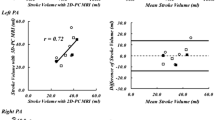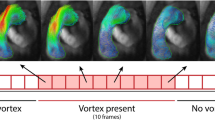Abstract
Background
Pulmonary venous (PV) obstruction may complicate surgical repair of PV abnormalities. By combining phase-contrast cine (PC) imaging and contrast-enhanced angiography, magnetic resonance (MR) imaging can provide physiological information complementing anatomical diagnosis.
Objectives
To compare the PV flow pattern observed after surgical repair of PV abnormalities with normal PV flow pattern and to investigate the changes occurring in the presence of PV stenosis by using PC MR in children.
Materials and methods
By using PC MR, PV flow was evaluated in 14 patients (3 months-14 years) who underwent surgical repair for PV abnormalities. Eleven children (8–18 years) were studied as normal controls. Peak flow velocities and patterns were compared among three groups: normal veins (n=23), surgically repaired veins without (n=44) and with stenosis (n=10).
Results
Normal and unobstructed pulmonary veins after surgery showed a biphasic or triphasic flow pattern with one or two systolic peaks and a diastolic peak. Unobstructed surgically repaired veins showed decreased peak systolic velocity (P =0.001) and an increased peak diastolic velocity (P=0.005) when compared to normal values. Obstructed veins showed decreased systolic and diastolic velocities when measured upstream from the stenosis.
Conclusion
PC MR shows different flow patterns among normal, surgically repaired pulmonary veins with and without stenosis.


Similar content being viewed by others
References
Freedom RM, Mawson MB, Yoo SJ, et al (1997) Abnormalities of pulmonary venous connections including subdivided left atrium. In: Congenital heart disease. Textbook of angiocardiography. Futura, Armonk, pp 665–705
Krabill KA, Lucas RV (1990) Congenital cardiac anomalies producing pulmonary venous obstruction (1990). In: Moller JH, Neal WA (eds) Fetal, neonatal, and infant cardiac disease. Appleton & Lange, Norwalk, pp 709–722
Caldarone CA, Najm HK, Smallhorn JF, et al (1998) Relentless pulmonary vein stenosis after repair of total anomalous pulmonary venous drainage. Ann Thorac Surg 66:1514–1520
Hyde JA, Stumper O, Barth MJ, et al (1999) Total anomalous pulmonary venous connection: outcome of surgical correction and management of recurrent venous obstruction. Eur J Cardiothorac Surg 15:735–740
Smallhorn JF, Freedom RM (1986) Pulsed Doppler echocardiography in the preoperative evaluation of total anomalous pulmonary venous connection. J Am Coll Cardiol 8:1413–1420
Smallhorn JF, Burrows P, Wilson G, et al (1987). Two-dimensional and pulsed Doppler echocardiography in the postoperative evaluation of total anomalous pulmonary venous connection. Circulation 76:298–305
Smallhorn JF, Pauperio H, Benson L, et al (1985) Pulsed Doppler assessment of pulmonary vein obstruction. Am Heart J 110:483–486
Obeid AI, Carlson RJ (1995) Evaluation of pulmonary vein stenosis by transoesophageal echocardiography. J Am Soc Echocardiogr 8:888–896
White CS (2000) MR Imaging of thoracic veins. MRI Clin North Am 8:17–32
Ferrari VA, Scott CH, Holland GA, et al (2001) Ultrafast three-dimensional contrast-enhanced magnetic resonance angiography and imaging in the diagnosis of partial anomalous pulmonary venous drainage. J Am Coll Cardiol 37:1120–1128
Choe YH, Lee HJ, Kim HS, et al (1994) MRI of total anomalous pulmonary venous connection. J Comput Assist Tomogr 18:243–249
Greil G, Powell AJ, Gildein HP, et al (2002) Gadolinium-enhanced three-dimensional MR angiography of pulmonary and systemic venous anomalies. J Am Coll Cardiol 39:335–341
Valsangiacomo ER, Levasseur S, McCrindle BW, et al (2003) Contrast-enhanced MR angiography of pulmonary venous abnormalities in children. Pediatr Radiol 33:92–98
Meier D, Maier S, Boesiger P (1988) Quantitative flow measurements on phantoms and on blood vessels with MR. Magn Reson Med 8:25–34
Van Rossum AC, Sprenger M, Visser FC, et al (1991) An in vivo validation of quantitative blood flow imaging in arteries and veins using magnetic resonance phase-shift techniques. Eur Heart J 12:117–126
Mohiaddin RH, Amanuma M, Kilner PJ, et al (1991) MR phase-shift velocity mapping of mitral and pulmonary venous flow. J Comput Assist Tomogr 15:237–243
Mostbeck GH, Caputo GR, Higgins CB (1992) MR measurement of blood flow in the cardiovascular system. AJR 159:453–461
Rebergen SA, van der Wall EE, Doornbos J, et al (1993) Magnetic resonance measurement of velocity and flow: technique, validation and cardiovascular applications. Am Heart J 126:1439–1456
Lee VS, Spritzer CE, Carroll BA, et al (1997) Flow quantification using fast cine phase-contrast MR imaging, conventional cine phase-contrast MR imaging, and Doppler sonography: in vitro and in vivo validation. AJR 169:1125–1131
Mohiaddin RH, Pennell DJ (1998) MR blood flow measurement. Cardiol Clin 16:161 –178
Powell AJ, Maier SE, Chung T, et al (2000) Phase-velocity cine magnetic resonance imaging measurement of pulsatile blood flow velocity in children and young adults: in vitro and in vivo validation. Pediatr Cardiol 21:104–110
Papaharilaou Y, Doorly DJ, Sherwin SJ (2001) Assessing the accuracy of two-dimensional phase contrast MRI measurements of complex unsteady flows. J Magn Reson Imaging 14:714–723
Greil G, Geva T, Maier SE, et al (2002). Effect of acquisition parameters on the accuracy of velocity encoded cine magnetic resonance imaging blood flow measurements. J Magn Reson Imaging 15:47–54
Galjee MA, Van Rossum AC, van Eenige MJ, et al (1995) Magnetic resonance imaging of the pulmonary venous flow pattern in mitral regurgitation. Indipendence of the investigated vein. Eur Heart J 16:1675–1685
Videlefsky N, Parks WJ, Oshinski J, et al (2001) Magnetic resonance phase-shift velocity mapping in pediatric patients with pulmonary venous obstruction. J Am Coll Cardiol 38:262–267
Najm HK, Caldarone CA, Smallhorn JF, et al (1998) A sutureless technique for the relief of pulmonary vein stenosis with the use of in situ pericardium. J Thorac Cardiovasc Surg 115:468–470
Keren G, Sherez J, Megidish R, et al (1985) Pulmonary venous flow pattern—its relationship to cardiac dynamics. A pulsed Doppler echocardiographic study. Circulation 71:1105–1112
Smallhorn JF, Freedom RM, Olley PM (1987) Pulsed Doppler echocardiographic assessment of extraparenchymal pulmonary vein flow. J Am Coll Cardiol 9:573–579
Abdurrahman L, Hoit BD, Banerjee A, et al (1998) Pulmonary venous flow Doppler velocities in children. J Am Soc Echocardiogr 11:132–137
DeMarchi SF, Bodenmueller M, Lai DL, Seiler C (2001) Pulmonary venous flow velocity pattern in 404 individuals without cardiovascular disease. Heart 85:23–29
Minich LA, Tani LY, Hawkins JA, et al (1995) Abnormal Doppler pulmonary venous flow patterns in children after repaired total anomalous pulmonary venous connection. Am J Cardiol 75:606–610
Smallhorn JF, Gow R, Freedom RM, et al (1986) Pulsed Doppler echocardiographic assessment of the pulmonary venous pathway after the Mustard or Senning procedure for transposition of the great arteries. Circulation 73:765–774
Kilner PJ, Firmin DN, Rees RS, et al (1991) Valve and great vessel stenosis: assessment with MR jet velocity mapping. Radiology 178:229–235
Masuyama T, Lee JM, Tamai M, et al (1991) Pulmonary venous flow velocity pattern as assessed with transthoracic pulsed Doppler echocardiography in subjects without cardiac disease. Am J Cardiol 67:1396–1404
Klein AL, Burstow DJ, Tajik AJ, et al (1994) Effects of age on left ventricular dimensions and filling dynamics in 117 normal persons. Mayo Clin Proc 69:212–224
Author information
Authors and Affiliations
Corresponding author
Rights and permissions
About this article
Cite this article
Valsangiacomo, E.R., Barrea, C., Macgowan, C.K. et al. Phase-contrast MR assessment of pulmonary venous blood flow in children with surgically repaired pulmonary veins. Pediatr Radiol 33, 607–613 (2003). https://doi.org/10.1007/s00247-003-0983-9
Received:
Accepted:
Published:
Issue Date:
DOI: https://doi.org/10.1007/s00247-003-0983-9




